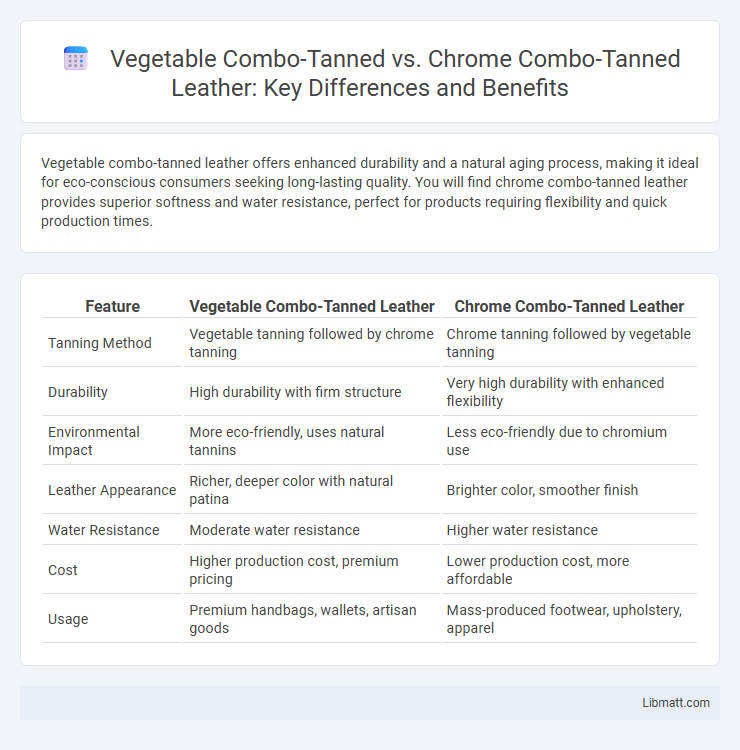Vegetable combo-tanned leather offers enhanced durability and a natural aging process, making it ideal for eco-conscious consumers seeking long-lasting quality. You will find chrome combo-tanned leather provides superior softness and water resistance, perfect for products requiring flexibility and quick production times.
Table of Comparison
| Feature | Vegetable Combo-Tanned Leather | Chrome Combo-Tanned Leather |
|---|---|---|
| Tanning Method | Vegetable tanning followed by chrome tanning | Chrome tanning followed by vegetable tanning |
| Durability | High durability with firm structure | Very high durability with enhanced flexibility |
| Environmental Impact | More eco-friendly, uses natural tannins | Less eco-friendly due to chromium use |
| Leather Appearance | Richer, deeper color with natural patina | Brighter color, smoother finish |
| Water Resistance | Moderate water resistance | Higher water resistance |
| Cost | Higher production cost, premium pricing | Lower production cost, more affordable |
| Usage | Premium handbags, wallets, artisan goods | Mass-produced footwear, upholstery, apparel |
Introduction to Leather Tanning Methods
Vegetable combo-tanned leather combines traditional vegetable tanning with chrome tanning, enhancing durability while retaining natural characteristics and eco-friendliness. Chrome combo-tanned leather uses a mix of chromium salts and vegetable tannins, offering superior softness, flexibility, and water resistance compared to purely vegetable-tanned options. These hybrid tanning methods optimize leather quality by balancing environmental impact, strength, and aesthetic appeal.
What is Vegetable Combo-Tanned Leather?
Vegetable combo-tanned leather combines traditional vegetable tanning with chromium tanning methods to enhance durability and flexibility. The vegetable tanning process uses natural tannins from tree bark, leaves, and fruits, which impart a rich, natural finish and increase the leather's firmness and longevity. This hybrid tanning method results in leather that maintains a balance between eco-friendly qualities and improved water resistance, making it ideal for high-quality leather goods.
What is Chrome Combo-Tanned Leather?
Chrome combo-tanned leather combines the durability and water resistance of chrome tanning with the natural feel and rich texture of vegetable tanning. This hybrid method involves first treating the hide with chromium salts for strength and flexibility, followed by vegetable tannins to enhance color depth and aging characteristics. The result is leather that offers both the robustness of chrome tanning and the aesthetic appeal typical of vegetable-tanned leather, making it ideal for high-quality footwear and leather goods.
Key Differences Between Vegetable and Chrome Combo-Tanning
Vegetable combo-tanned leather uses natural tannins from plant sources, providing an eco-friendly and breathable material with a firm texture, whereas chrome combo-tanned leather utilizes chromium salts for faster production and increased softness and flexibility. The key differences lie in durability, environmental impact, and finish quality; vegetable tanning results in stiffer leather that patinas over time, while chrome tanning offers water resistance and a more uniform color. Understanding these distinctions helps you select the best leather type based on your product's intended use and sustainability preferences.
Environmental Impact: Vegetable vs. Chrome Combo-Tanned
Vegetable combo-tanned leather uses natural tannins derived from tree bark and plants, making it biodegradable and less harmful to ecosystems compared to chrome combo-tanned leather, which involves chromium salts that can release toxic waste and heavy metals during processing. The disposal of chrome-tanned leather poses significant environmental challenges due to its resistance to biodegradation and potential soil and water contamination. Sustainable leather production increasingly favors vegetable tanning for its lower environmental footprint and reduced chemical hazards.
Durability and Performance Comparison
Vegetable combo-tanned leather offers enhanced durability through its natural tanning agents, providing superior resistance to wear and tear while maintaining breathability and flexibility. Chrome combo-tanned leather boasts excellent performance in water resistance and color retention, making it ideal for products requiring consistent appearance and lightweight feel. Your choice depends on whether you prioritize long-lasting toughness and eco-friendliness (vegetable) or durability paired with moisture resistance and vibrant finishes (chrome).
Aesthetic Qualities and Aging Process
Vegetable combo-tanned leather offers a rich, natural patina that deepens in color and texture over time, enhancing its aesthetic appeal with age. Chrome combo-tanned leather provides consistent color retention and a smoother surface, maintaining its initial appearance longer but with less character development. The aging process of vegetable combo-tanned leather highlights unique grain variations and a warm, organic finish, while chrome combo-tanned leather resists wear and fading but may lack the evolving beauty of natural aging.
Ideal Uses for Vegetable Combo-Tanned Leather
Vegetable combo-tanned leather is ideal for crafting high-quality leather goods such as wallets, belts, and shoes that require durability and a natural finish. Its eco-friendly tanning process enhances the leather's breathability and aging characteristics, making it suitable for products exposed to frequent wear. Choosing vegetable combo-tanned leather ensures your items develop a unique patina over time, increasing their aesthetic appeal and longevity.
Applications of Chrome Combo-Tanned Leather
Chrome combo-tanned leather offers enhanced durability, flexibility, and water resistance, making it ideal for footwear, upholstery, and fashion accessories. Its quick tanning process and consistent quality suit high-volume production for items like bags, gloves, and sports equipment. You benefit from the versatility and strength of chrome combo-tanned leather in products that demand both aesthetic appeal and functional performance.
Choosing the Right Tanning Method for Your Needs
Choosing between vegetable combo-tanned and chrome combo-tanned leather depends on desired durability, environmental impact, and end-use. Vegetable combo-tanned leather offers a more natural, eco-friendly option with a firmer texture ideal for luxury goods, while chrome combo-tanned leather provides greater water resistance, flexibility, and faster production suitable for mass-market products. Assessing factors like longevity, aesthetics, and sustainability helps determine the most appropriate tanning method for your specific leather requirements.
Vegetable combo-tanned vs chrome combo-tanned Infographic

 libmatt.com
libmatt.com